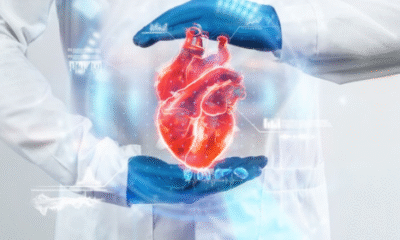Health
Understanding Autosomal Genetic Disorders – Common Examples and Their Symptoms
Autosomal genetic disorders result from mutations in genes located on autosomal chromosomes. Let’s explore two prevalent autosomal genetic disorders and their associated symptoms.
1. Cystic Fibrosis (CF): Respiratory and Digestive Complications
Cystic fibrosis is caused by mutations in the CFTR gene, affecting the production of mucus, sweat, and digestive juices. Symptoms include persistent coughing, wheezing, difficulty breathing, frequent lung infections, poor growth, and digestive issues like malabsorption.
2. Neurofibromatosis (NF): Tumors of the Nervous System
Neurofibromatosis, type 1 and type 2, results from mutations in the NF1 and NF2 genes, respectively. Symptoms of NF1 include café-au-lait spots, neurofibromas, and optic gliomas. NF2 symptoms include hearing loss, balance issues, cataracts, and tumors on nerves.
3. Phenylketonuria (PKU): Metabolic Disorder
PKU is caused by mutations in the PAH gene, leading to a buildup of phenylalanine in the body. Symptoms include intellectual disability, developmental delays, seizures, behavioral problems, and a musty odor in the urine or sweat.
4. Huntington’s Disease: Neurological Degeneration
Huntington’s disease results from mutations in the HTT gene, causing progressive degeneration of nerve cells in the brain. Symptoms include involuntary movements, cognitive decline, psychiatric disturbances, and difficulty with speech and swallowing.
5. Marfan Syndrome: Connective Tissue Disorder
Marfan syndrome is caused by mutations in the FBN1 gene, affecting connective tissue throughout the body. Symptoms include tall stature, long limbs, joint hypermobility, scoliosis, heart defects, and vision problems such as lens dislocation.
6. Down Syndrome: Chromosomal Abnormality
Down syndrome is caused by the presence of an extra chromosome 21. Symptoms include intellectual disability, distinctive facial features, poor muscle tone, heart defects, gastrointestinal issues, and increased risk of leukemia and Alzheimer’s disease.
7. Turner Syndrome: Sex Chromosome Abnormality
Turner syndrome results from a missing or partially missing X chromosome in females. Symptoms include short stature, delayed puberty, infertility, heart defects, kidney abnormalities, and learning disabilities.
8. Fragile X Syndrome: Intellectual Disability
Fragile X syndrome is caused by a mutation in the FMR1 gene, leading to intellectual disability and behavioral challenges. Symptoms include developmental delays, learning disabilities, social anxiety, hyperactivity, and repetitive behaviors.
9. Duchenne Muscular Dystrophy (DMD): Progressive Muscle Weakness
Duchenne muscular dystrophy is caused by mutations in the DMD gene, resulting in progressive muscle weakness and wasting. Symptoms include delayed motor milestones, difficulty walking, frequent falls, muscle cramps, and respiratory and cardiac complications.
10. Prader-Willi Syndrome: Developmental and Behavioral Issues
Prader-Willi syndrome is caused by the loss of genes in a specific region of chromosome 15. Symptoms include poor muscle tone, feeding difficulties in infancy, excessive eating and weight gain, developmental delays, behavioral problems, and cognitive impairment.
11. Alport Syndrome: Kidney Disease and Hearing Loss
Alport syndrome is caused by mutations in genes encoding collagen proteins in the basement membranes of the kidneys, ears, and eyes. Symptoms include hematuria, proteinuria, progressive kidney disease, sensorineural hearing loss, and ocular abnormalities.
12. Polycystic Kidney Disease (PKD): Renal Cysts and Kidney Dysfunction
Polycystic kidney disease results from mutations in the PKD1 or PKD2 genes, leading to the formation of fluid-filled cysts in the kidneys. Symptoms include abdominal pain, high blood pressure, urinary tract infections, kidney stones, and progressive kidney failure.
13. Tay-Sachs Disease: Neurological Degeneration
Tay-Sachs disease is caused by mutations in the HEXA gene, leading to the accumulation of gangliosides in nerve cells. Symptoms include developmental regression, loss of motor skills, seizures, vision and hearing loss, and eventual paralysis and death.
14. Ehlers-Danlos Syndrome (EDS): Connective Tissue Disorder
Ehlers-Danlos syndrome is a group of disorders caused by mutations in genes related to collagen production. Symptoms include joint hypermobility, skin hyperextensibility, easy bruising, chronic pain, and increased risk of joint dislocations and organ rupture.
15. Von Hippel-Lindau (VHL) Disease: Tumor Formation
Von Hippel-Lindau disease results from mutations in the VHL gene, predisposing individuals to the development of tumors in various organs. Symptoms include retinal angiomas, central nervous system hemangioblastomas, renal cell carcinoma, pancreatic cysts, and pheochromocytomas.
Health
Top-Rated Heart Hospital in Hyderabad: Your Guide to the Best Cardiology Care
Hyderabad, a bustling hub of healthcare innovation, has earned its place as a destination for world-class heart treatment. From advanced cardiac procedures to compassionate patient care, the city is home to some of the most renowned hospitals in India. Whether you’re seeking routine cardiology consultations or complex heart surgeries, Hyderabad’s heart hospitals offer a perfect blend of modern technology and experienced specialists.
In this article, we explore what makes the city a leading heart care destination and help you discover the Heart Hospital in Hyderabad for your needs.
Why Choose a Heart Hospital in Hyderabad?
Hyderabad has grown to become one of India’s top healthcare destinations, especially for cardiac care. Here’s why:
- World-Class Infrastructure: Heart hospitals in Hyderabad are equipped with cutting-edge technology like robotic surgery systems, advanced cath labs, 3D imaging, and hybrid operating rooms.
- Highly Skilled Cardiologists: Many cardiologists and cardiac surgeons practicing in Hyderabad are globally trained and have decades of experience treating critical heart conditions.
- Affordable Yet Quality Care: Compared to Western countries, and even some Indian metros, Hyderabad offers cost-effective cardiac treatments without compromising on quality.
- Global Patient Footfall: Patients from across the globe — especially from Africa, the Middle East, and neighboring South Asian countries — visit Hyderabad for heart treatment, thanks to its high success rates and warm hospitality.
Services Offered by Top Heart Hospitals
The leading best cardiology hospital in hyderabad will typically provide a wide spectrum of services under one roof. These include:
- Preventive Cardiology: Early detection and lifestyle counseling to manage risk factors like hypertension, cholesterol, and diabetes.
- Interventional Cardiology: Non-surgical treatments such as angioplasty, stenting, and catheter-based procedures.
- Cardiac Surgery: Bypass surgeries (CABG), valve replacements, congenital heart defect repairs, and minimally invasive heart surgeries.
- Electrophysiology: Treatment for rhythm disorders, pacemaker or ICD implantation, and ablation procedures.
- Rehabilitation & Follow-up Care: Cardiac rehab programs for recovery, lifestyle change, and long-term heart health.
These hospitals are also equipped to handle cardiac emergencies 24/7, with rapid response units and ICU care.
How to Choose the Right Hospital?
Choosing the right hospital can be a life-changing decision. Keep these factors in mind:
- Experience and Reputation: Check for hospitals with a track record of high success rates and experienced cardiac teams.
- Technology and Facilities: Look for NABH/JCI accreditation, modern operation theatres, and advanced diagnostic labs.
- Patient Testimonials: Real-life stories often reflect the hospital’s commitment to care and successful recovery journeys.
- Location and Accessibility: Choose a hospital that’s easily reachable in case of emergencies.
- Cost and Insurance Support: Transparent pricing and insurance partnerships make treatment smoother.
Notable Heart Hospitals in Hyderabad
Here are some of the reputed names in the field of cardiology in Hyderabad:
- Apollo Hospitals, Jubilee Hills: Known for its pioneering work in cardiac care, including robotic surgeries and heart transplants.
- CARE Hospitals, Banjara Hills: Offers comprehensive cardiac treatments and is known for high success rates in angioplasty and bypass surgeries.
- Yashoda Hospitals: Equipped with advanced diagnostic and surgical facilities, and experienced in both pediatric and adult cardiology.
- KIMS Hospitals, Secunderabad: A preferred center for heart patients looking for affordable, high-end cardiac procedures.
Each of these hospitals is supported by world-class infrastructure, round-the-clock care, and experienced cardiologists, making them top choices for heart treatment in the city.
Final Thoughts
If you or your loved ones are dealing with a heart-related condition, you’re in safe hands in Hyderabad. The city continues to lead the way in cardiac healthcare, combining compassion, innovation, and excellence.
Health
Managing Nerve Pain: Diagnosis and Treatments

What is nerve pain?
Nerve pain can be one of the most uncomfortable and frustrating health issues to deal with. The sensation is often described as burning, stabbing, shooting or a combination of all three. The pain may be chronic, or come and go. This pain occurs as a result of damage or irritation to the nerves of your body and can arise from injuries, medical conditions such as diabetes, infections, and even in some cases following surgery.
Getting the right diagnosis
The next step for most anyone suffering with nerve pain are the next steps to getting properly diagnosed. Many people suffer with pain for years without ever knowing the cause. The way doctors look for the cause of nerve pain is to first perform a physical examination and then start with a discussion about the pain. They are usually interested in when it started, what makes it better or worse, and whether you have other medical problems. They usually do blood work, nerve studies, and/or scans like CAT or MRI to help find the cause of your pain.
Pain management specialist
If they identify a cause they will begin to help you to put together a plan of treatment. And this is when a pain management specialist can really help you. Pain management doctors help to reduce pain and improve quality of life through medical treatment. They use both medicine and patient-centered approaches like behavioral social and emotional support, in decisions related to care. They will work to find the most efficacious treatment options for you.
Treatment Approaches for Nerve Pain
Treatment options for nerve pain may include medication. Some medications decrease nerve sensitivity, while others decrease swelling or muscle spasms. Physical therapy is commonly prescribed to increase strength and flexibility, and lessen pain as time goes on.
For some patients, advanced treatment options with injections, nerve blocks, or electrical nerve stimulation can provide great pain relief. These treatments directly target the affected nerve areas where the pain signals originate, and calm them down. If the pain is due to nerve compression/damage that can be repaired, then surgery may be considered.
Lifestyle Changes That Support Relief
Lifestyle changes also help manage neck pain. Some lifestyle changes that can be helpful include regular gentle exercise, good diet, and good sleep habits. Decreasing stress with activities such as meditation, yoga, or listening to music can be beneficial as stress will generally intensify the pain experience.
Acting early
It’s important to keep in mind that nerve pain will not (may not) go away entirely, but, if it is taken care of appropriately, it can be managed effectively. Early assessment and a customized treatment plan can provide the ability to prevent the pain from worsening and continue on with your daily activities.
If you experience ongoing pain, which does not go away, you should get advice for an assessment. You should not ignore the symptoms or wait too long before getting help to manage them. The earlier you act, the better your chance of finding relief and preserving your nerve health.
Health
Restore Comfort and Mobility with Advanced Non-Surgical Sciatica Treatment
Do you often feel sharp pain that travels from your lower back to your legs? This radiating discomfort, known as sciatica, can make simple movements such as sitting, bending, or walking extremely painful. It usually occurs when the sciatic nerve, which runs from the lower spine down both legs, becomes irritated or compressed.
Ignoring the condition or relying only on painkillers can make the pain worse over time. With modern non-surgical Sciatica Treatment, you can relieve nerve pressure, improve mobility, and achieve lasting comfort naturally.
Sciatica is not a condition on its own but a result of underlying spinal problems. Several factors can contribute to sciatic nerve irritation, such as:
● Herniated or bulging discs pressing against the sciatic nerve
● Narrowing of the spinal canal, also known as spinal stenosis
● Inflammation or tightness in the lower back muscles
● Poor posture and sedentary habits that stress the lower spine
When these factors combine, they compress the sciatic nerve and cause pain, numbness, or weakness that can travel down one or both legs.
Sciatica symptoms can range from mild to severe, depending on the extent of nerve compression. You may experience:
● Sharp or shooting pain in the lower back, buttocks, or legs
● Tingling or numbness that spreads down the leg
● Muscle weakness that makes it hard to walk or stand
● Pain that worsens with sitting or sudden movement
If any of these signs persist, professional Sciatica Treatment can help address the root cause and prevent further damage.
Non-Surgical Sciatica Treatment at ANSSI Wellness
At ANSSI Wellness, we specialise in safe, non-invasive care designed to treat sciatica naturally. Our advanced therapies target the underlying issue rather than masking the symptoms.
Spinal Decompression Sciatica Treatment
This gentle and computer-guided therapy relieves pressure on the sciatic nerve and promotes disc healing.
Physical Therapy for Sciatica
Tailored exercises strengthen spinal muscles, correct posture, and improve flexibility for long-term comfort.
Chiropractic Adjustments
Precise spinal alignments that reduce nerve irritation and restore natural mobility.
Massage Therapy
Focused muscle relaxation that improves blood circulation and releases deep-seated tension.
Heat and Cold Therapy
Alternating warmth and cold to manage inflammation and provide soothing relief.
Lifestyle Guidance
Expert advice on posture, stretching, and ergonomic habits to prevent recurrence and maintain spine health.
Every Sciatica Treatment plan at ANSSI Wellness is customised based on the individual’s condition, ensuring safe and effective recovery without surgery or medication.
Why Choose Professional Sciatica Treatment
Attempting to manage sciatica at home may offer temporary comfort, but without professional care, the condition often returns. Expert-guided non-surgical Sciatica Treatment provides a structured plan that helps you recover faster and prevents long-term complications.
With early intervention, you can regain full mobility, reduce pain, and improve your quality of life naturally.
Begin Your Journey Toward a Pain-Free Life
You do not have to live with sciatic pain or limit your movement. At ANSSI Wellness, our advanced and holistic Sciatica Treatment helps relieve nerve compression, restore spinal balance, and promote lasting relief.


